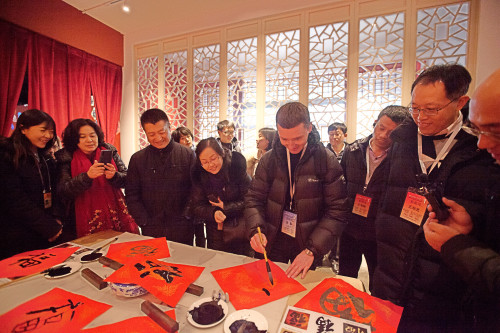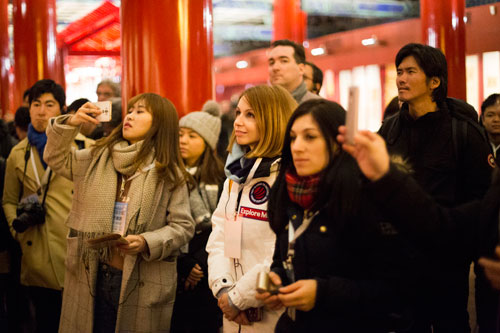
People’s Republic of China



On February 18, 2019, the Information Department of the Foreign Ministry and the Palace Museum co-hosted the activity of "Celebrating the Spring Festival in the Forbidden City" for foreign journalists in China. More than 100 people including foreign journalists in China, and relevant principals from the Information Department of the Foreign Ministry and the Palace Museum participated in this event.
Director-General of the Information Department of the Foreign Ministry Lu Kang said in his speech that the Spring Festival is a traditional Chinese holiday. The Information Department invited journalists to gather at the Forbidden City in celebration of the Spring Festival, hoping that through the exhibition of "New Year Greetings -- Celebrating the Spring Festival in the Forbidden City", we can all "travel back" to the history in the Forbidden City with most cultural deposits, experience the Spring Festival customs in ancient Chinese imperial palace and enjoy the atmosphere of the Lunar New Year. Meanwhile, we can enhance communication and understanding with each other in the festive and peaceful air. We welcome foreign journalists' in-depth coverage of the vivid and wonderful Chinese stories, striving to present a real, comprehensive, three-dimensional and diverse China.
Afterwards, foreign journalists cheerily visited the exhibition, enjoyed the palace lanterns, and tasted time-honored food. They visited the exhibition of "New Year Greetings -- Celebrating the Spring Festival in the Forbidden City" in the gallery of the Meridian Gate (Wu men). The nearly one thousand cultural relics, displayed in the main building and the eastern and western Yanchi Tower of the Meridian Gate, represented the Spring Festival customs of the imperial palace in Qing Dynasty, making the foreign journalists feel like as if they were in the warm atmosphere of the Spring Festival celebration of the imperial palace in ancient China. The visit to the three main halls of the Forbidden City has given the foreign journalists a deeper understanding of the Chinese "Harmony" culture. The auspicious poetic couplets (chunlian) and images of guardian gods (menshen, lit. "gate god") on the doors of palaces, lanterns decorated under the corridors of the Palace of Heavenly Purity (Qianqing gong) and Hall of Imperial Supremacy (Huangji dian), and heavenly lanterns (tiandeng) and longevity lanterns (wanshou deng) at the Palace of Heavenly Purity (Qianqing gong) were impressive with their beauty and exquisite craftsmanship. In the interactive activity of the digital exhibition set in the east corridor of the Palace of Heavenly Purity (Qianqing gong), foreign journalists wrote the Chinese character "Fu (blessing)", repainted the Chinese New Year pictures, and enjoyed the holographic project. Finally, they had traditional Chinese New Year's gourmets like dumplings and roast duck in Bingjiao Restaurant, tasting "a bite of Spring Festival".
Foreign journalists all said that this event was an unforgettable cultural trip and spiritual feast, which gives them a deeper understanding of traditional Chinese culture and a real experience of the Spring Festival culture and traditional customs in Chinese imperial palace. They expected that the Information Department of the Foreign Ministry would hold more such cultural exchange activities in the future. And they will continue to pay close attention to China's important internal and external agendas, and report China in a comprehensive and objective manner.



